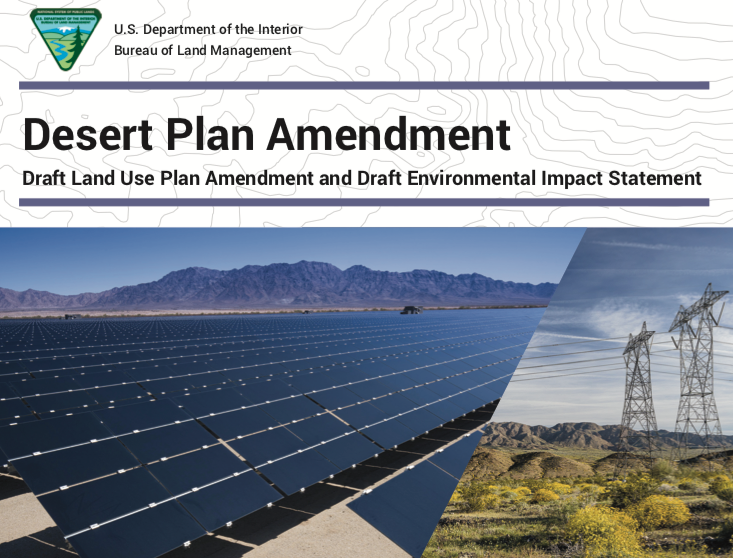Interior Department Cancels the Unpopular DRECP Amendment
February 18, 2021 - California Desert - The Department of the Interior, under the Biden Administration, signaled it would cancel the public comment period of the Environmental Impact Statement analyzing a gutting of the Desert Renewable Energy Conservation Plan (DRECP) that would only favor renewable energy developers. That DRECP amendment will be revokded. The amendment to the DRECP, initiated under the Trump Administration, would have removed protections on conservation lands and Areas of Critical Environmental Concern in order to accomodate more utility-scale solar projects on public lands. Mining industries would also have benefited. But federally threatened Mojave desdert tortoises would be impacted further.
In an official announcement, the Bureau of Land Management stated:
The Trump Administration moved to scrap the carefully developed plan, thereby undermining opportunities for renewable energy development and enduring conservation measures. In a Federal Register notice to be published in the coming days, the Department will formally revoke the Bureau of Land Management’s comment period on the Trump administration’s draft environmental impact statement to amend the DRECP.
A quote from Principal Deputy Assistant Secretary - Land and Minerals Management Laura Daniel Davis said in part:
"The Trump administration’s proposal in its final days to re-open the plan is unnecessary and at odds with balanced land management. The Department will not move forward with the proposed environmental review of potential amendments to the DRECP. We look forward to renewing our partnership with the state to build a clean energy economy that creates jobs, addresses climate change, and conserves public lands for current and future generations.”
Bernhardt's Parting Shot: Interior Slashes Conservation in the California Desert
January 14, 2021 - California Desert - As predicted, but much delayed, the Bureau of Land Management (BLM) released its proposed gutting of the Desert Renewable Energy Conservation Plan (DRECP), vastly increasing solar and wind energy areas at the expense of protected lands, public ands open spaces, and desert biodiversity across southern California.
This is very bad - over 2 million acres of conservation lands would be open to mining and of course solar and wind in the Mojave Desert and Sonoran/Coloradan Desert of California from the Owens Valley to the Mexican border. Streamlining and expediting renewable energy applications is included. Federally Threatened Mojave Desert tortoise Critical Habitat, Wilderness Study Areas, and Areas of Critical Environmental Concern (ACECs) are on the chopping block. Some of these ACECs were designated before the DRECP.
The solar industry has most likely been busy lobbying for opening up more land to commercial utility-scale solar development and Lithium mining (needed for energy storage options).
Basin & Range Watch is not surpised, as both Democrat and Republican administrations have sought to use public lands desert ecosystems as industrial energy sprawl areas for commercial profit, ignoring more sustainable alternatives that would instead prioritize Distributed Energy Resources, supported by science.
California Energy Commission Commissioner Karen Douglas voiced grave concerns on January 13, with this proposed plan amendment:
“We are disappointed that the BLM has unilaterally proposed amendments to the DRECP in the last days of the Trump administration,” Douglas said. “The DRECP was developed through a close partnership between California and BLM. It remains an important component of our state’s efforts to meet its ambitious climate and renewable energy goals, which will require major new investments in renewable energy projects. We look forward to working closely with the incoming Biden administration and hope it will set this proposal aside and instead focus on partnering with us to reinvigorate our longstanding partnership with BLM and other federal agencies to advance our mutual environmental goals.”
But will the Biden administration like this new DRECP plan, that prioritizes more public lands to bear the brunt of ambitious climate change and renewable energy goals? Even though throuought this website we have described how the desert actually sequesters Carbon, and if conserved as wildlands can help absorb CO2 emissions. Global 30 X 30 initiatives propose to protect 30% of Earth's ecosystems by 2030, yet desert ecosystems seem to be expendable in the eyes of many developers who simply seek flat landscapes with sunny skies and nearby high-voltage transmission lines to send energy to distant load centers, regardless of biodiversity and public access issues.
Senator Diane Feinstein (D-CA) wrote on her website how changing this massive plan made no sense:
“The Trump administration’s last-ditch effort to amend the Desert Renewable Energy Conservation Plan puts 2.2 million acres set aside for conservation at risk. We won’t let them undermine the plan days before leaving office."
Feinstein's landmark legislation originally protecting the desert, the California Desert Protection Act of 1994, is gradually being eroded away. Feinstein had said about the California Desert: “Teeming with life – from desert tortoises to bighorn sheep, breathtaking wildflower blooms to iconic Joshua trees – few places rival the unique beauty of California’s desert. The desert is a defining part of California’s landscape and we have a responsibility to preserve it for generations to come.”
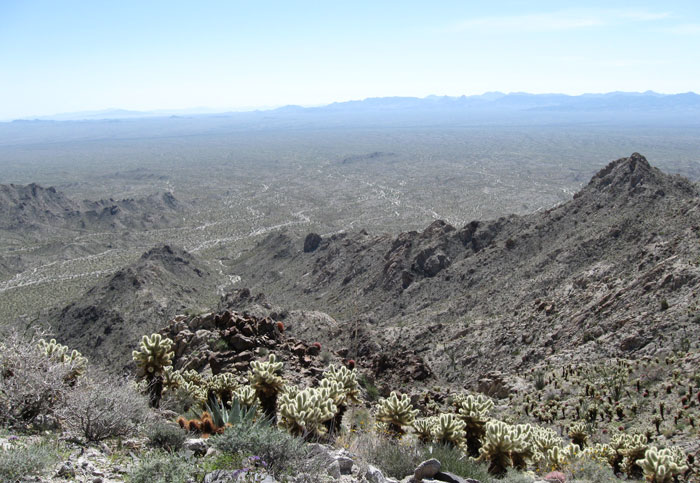
^California Desert: teddybear chollas and vista from the Chemehuevi Mountains.
Basin & Range Watch will be writing extensive comments opposing this plan, and seeking better alternatives, as we discuss this push with the incoming Secretary of Interior Deb Haaland. We are nearly finished with a Position Paper on Renewable Energy Impacts and Better Alternatives, that will go into our comments and to the Secretary.
BLM's news release seeks to support California in its ambitious renewable energy goals: "The targeted amendments provide flexibility and streamlining for siting renewable energy development within designated Development Focus Areas in an effort to continue to assist the state in their mandate of 60 percent energy from wind or solar by 2030."
And: "This proposal will add over 800,000 acres for renewable energy development and create a more measured approach to foster responsible off-highway vehicle recreation, rural broadband, and other important multiple-use projects - including those needed to meet California’s renewable energy mandates.”
So many hours were spent by environmental groups in the last decade crafting this "perfect conservation plan" for the California Desert. Be careful what you wish for...
2021-00579.pdf (federalregister.gov)
DEPARTMENT OF THE INTERIOR Bureau of Land Management [(LLCA930000.L13400000.DS0000.21X) MO#450014117] Notice of Availability of the Draft Desert Plan Amendment and Draft Environmental Impact Statement, California AGENCY: Bureau of Land Management, Interior. ACTION: Notice of availability. SUMMARY: In accordance with the National Environmental Policy Act of 1969, as amended, the Bureau of Land Management (BLM) has prepared a Draft Land Use Plan Amendment (LUPA) and Draft Environmental Impact Statement (EIS), for an amendment to the California Desert Conservation Area (CDCA) Plan and the Bakersfield and Bishop Resource Management Plans (RMPs). The Desert Plan Amendment Draft LUPA/EIS includes consideration of changes to the management or modification to the boundaries of 129 Areas of Critical Environmental Concern (ACECs). By this notice, the BLM is announcing the availability of the Draft LUPA/EIS. In order to comply with Federal regulations, the BLM is also announcing a comment period on proposed changes to the ACECs within the planning area.
The Trump Administration was never anti-renewable energy. Here is the Desert Plan Amendment Draft Land Use Plan Amendment/Environmental Impact Statement (draft LUPA/EIS) on the BLM eplanning website.
For more information, contact:
Jeremiah Karuzas, Renewable Energy Program Manager
(916) 978-4644
jkaruzas@blm.gov
To amend the three Land Use Plans that underlie the Desert Renewable Energy Conservation Plan - the California Desert Conservation Area Plan, the Bishop and Bakersfield Resource Management Plans.
The Bureau of Land Management (BLM) has released a draft Plan Amendment and associated Environmental Impact Statement to amend the three plans that underlie the Desert Renewable Energy Conservation Plan. The BLM is proposing targeted amendments to the California Desert Conservation Area Plan, the Bakersfield Resource Management Plan, and the Bishop Resource Management Plan. This amendment is intended to allow for greater management flexibility in order to better fulfill BLM's multi-use mandate and contribute to meeting our nation's energy needs. The amendment will achieve this goal while at the same time continuing to ensure the conservation of resources and public uses in the southern California Desert.
https://eplanning.blm.gov/eplanning-ui/project/109248/510
How to Comment:
The BLM encourages the public to review and provide comments on the Draft LUPA/EIS. The document is available on the project website at: https://go.usa.gov/x7hdj. Hard copies are also available for public review at the BLM California State Office and BLM Field Offices within the planning area. Public comments will be accepted for 90 calendar days following the Environmental Protection Agency’s publication of its Notice of Availability in the Federal Register, which would be April 13, 2012. The BLM can best use your comments and resource information submissions if received within the review period.
Written comments may be submitted as follows (submittal of electronic comments is encouraged):
Electronically at: https://go.usa.gov/x7hdj
In hard copy and mailed directly or delivered to the BLM at: Bureau of Land Management, California State Office
Attn: Desert Plan Amendment 2800 Cottage Way, Suite W-1623 Sacramento, CA 95825
Trump Administration Set to Deconstruct the DRECP in January
December 4, 2019 - Basin and Range Watch had a conservation with staff of the Bureau of Land Management (BLM) recently over the Desert Renewable Energy Conservation Plan (DRECP), and we were told the changes should be coming in January 2020. BLM tells us that the size of Conservation Areas, such as Areas of Critical Environmental Concern, will not be reduced, but that the Conservation Management Actions (CMAs) will be weakened. This would most likely translate into increasing disturbance caps. Will utility-scale solar projects be allowed as long as the desert is "mowed", as is the current new mitigation trend? We do not support any weakening of Conservation Areas.
DRECP Public Meetings Contentious
March 2, 2018 - Lone Pine CA - We attended the Desert Renewable Energy Conservation Plan (DRECP) public meeting hosted by Bureau of Land Management (BLM) on February 26 in Lone Pine CA held in the local Film History Museum. It was a rather fun and bizarre venue to hold a government meeting, the small size of the building and theater meant everyone was crowded into an area filled with life-sized cut-outs of Western Movie Stars such as Roy Rogers, and large posters of 1930s and later Hollywood movies.
But what is not being revealed is that the overgeneration problem continues in California, and severely limits how much new utility-scale solar generation can be added to the grid. No discussion of valuable rooftop solar plus battery storage was brought up. We beleive this is the true solution to increasing renewable energy, not developing more desert wildlands.
But reaching California's Renewable Portfolio Standard of 33% by 2020 was not the only controversy: basic democracy seems to be eroding.
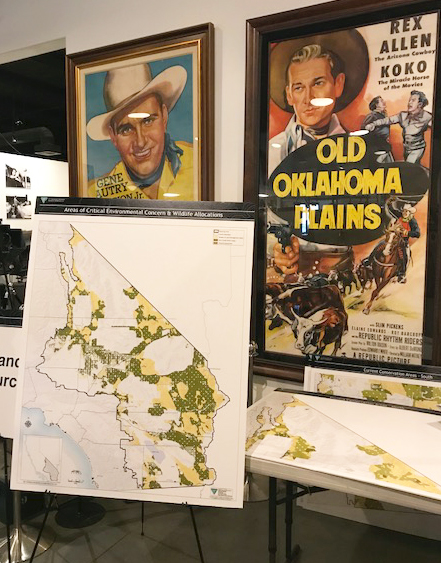
^DRECP map in front of Hollywood Old West movie posters at the Lone Pine Film History Museum (worth a separate visit!)
The building was plainly not large enough for the audience of at least 150 people, both locals and others (like us) who traveled hours to come to the meeting because we value the California Desert. And when BLM announced they would not take spoken public comments (only written or typed into the government laptop), the crowd complained vociferously.
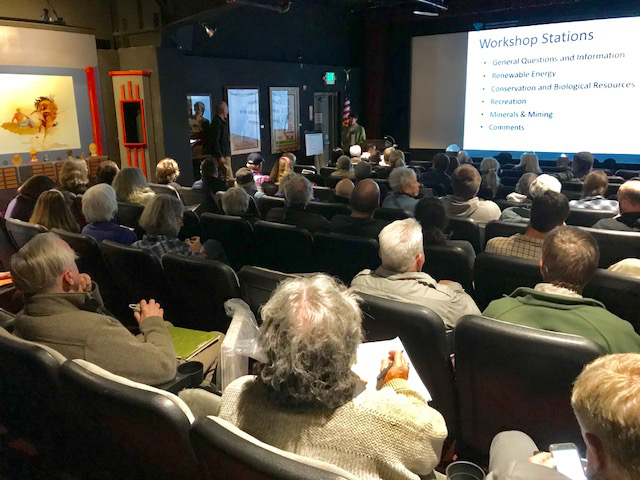
^ The audience did not appreciate being quieted by the goevrnment, about what will happen on public land.
Some members of the public (including us) stood up to protect outloud the inability of the people to give a sporkn public comment. BLM contractors refused to allow comments. Some people walked out. Others grumbled and booed. The BLM contractor running the meeting threatened to shut the whole meeting down immediately unless we became quiet.
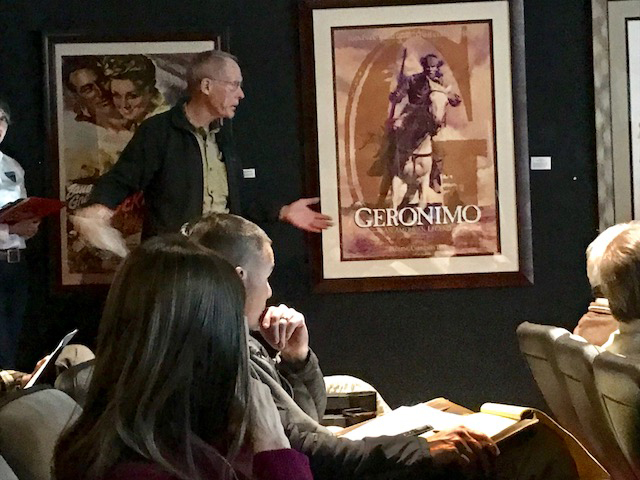
^Members of the pubic stood up to protest the lack of oral public comment allowed over potential changes to 22 million acres of public land in the California Desert. (Is the poster symbolic?)
In February 2018 the Bureau of Land Management (BLM) published a Notice of Intent to amend the three Land Use Plans within the DRECP planning area and initiated a public scoping process. This meeting was the first in that scoping meeting series. Other meetings were held in Hesperia, Joshua Tree, El Centro, and another will be in Bakersfield CA.
The three Land Use Plans that are being amended include:
1. The California Desert Plan of 1980
2. The Bishop Resource Management Plan
3. The Bakersfield Resource management Plan
Two Executive Orders by President Trump recently re-opened the DRECP in order to examine how land use designations have on commercial-scale renewable energy projects, as well as on increasing opportunities for expanding multiple uses on public lands (such as mining, grazing, and OHV recreation).
Basically, the entire DRECP has been thrown open for change, despite 8 long years of commenting, negotiation, and blood and tears by numerous local stakeholders across the desert.

The scoping process allows members of the public to share concerns, comments, and issues they are aware of about renewable energy and multiple use. Yet denying the public the ability to give spoken comments discriminated against people who may have a disability and cannot write, or citizens who have English as their second language, or those who are illiterate. We demanded another BLM public meeting be scheduled that would accept and record spoken public comment, but were denied.
Regarding California's 33% RPS, the state already has acheived 30% presently, according to Karen Douglas, chair of the California Energy Commission speaking in fron of the Inyo County Board of Supervisors on February 27. She admitted that the state had overshot their solar goals, and now had to wait to decide how to move forward. But she was not clear that this was due to the build-out of utilty-scale solar onto the grid, causing grid congestion. What is needed now is not more renewable energy in the desert, but more storage, as would be provided by rooftop solar in cities coupled with advanced batteries. We are not hearing the whole story. There is no need to open up the DRECP for more renewable energy.
Submit comments by email to: BLM_CA_DRECP@blm.gov
The website is: blm.gov/eplanDRECP
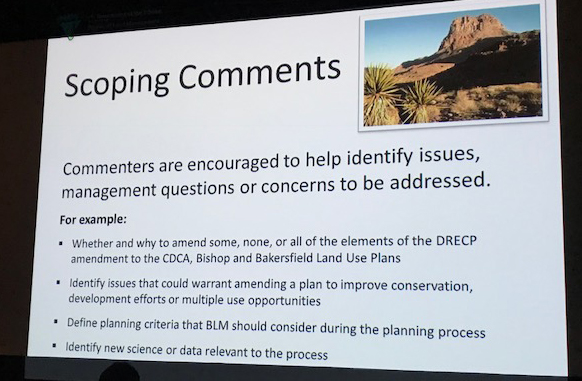
^BLM slide on scoping comments.
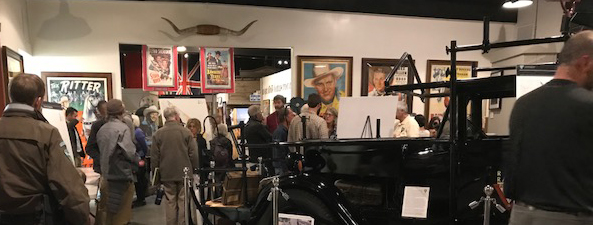
^The crowded public meeting held at the Lone Pine Film History Museum.
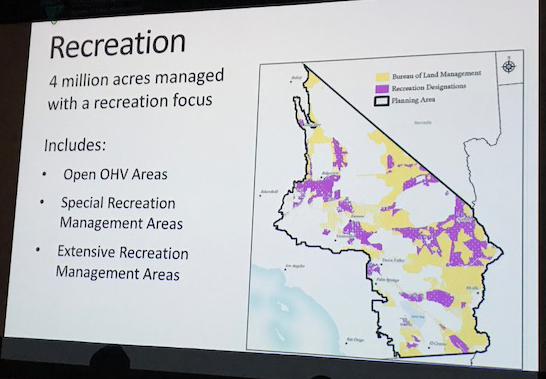
^Many maps were shown as posters.
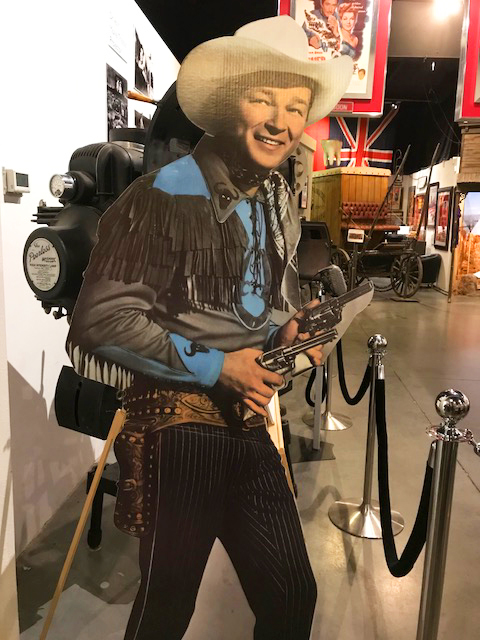
^Roy Rogers mingled with the public and BLM personnel during the meeting on the future of the desert. Lone Pine Film History Museum.
The Desert Sun has a report about another meeting in the California Desert.
Larger Changes to DRECP Proposed by BLM
February 8, 2018 - California Desert - The Trump Administration would apparently like to open up even more California Desert to massive renewable energy sprawl. We predicted this would happen as the original 22.6 million-acre DRECP was weakly made, vague, and did not include the counties and private land owners. Too much streamlining was built into the plan, opening it up to attack in different administrations.
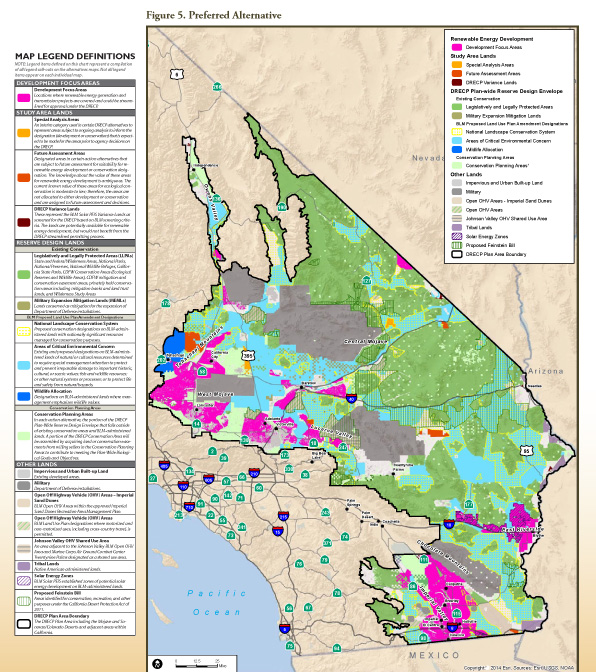
^An earler Preferred Alternative of the DRECP in 2015.
The BLM press release states: " The public is encouraged to provide input on how land designations identified as part of the DRECP process might affect development of solar, wind or other renewable energy resources. The comments will be used to help set the parameters, or scope, of the review of the land use plans.
"The public scoping meetings provide the public an opportunity to talk to resource specialists and submit written comments in person. Comments may also be submitted until March 22, 2018, to the BLM-California State Director, 2800 Cottage Way, Rm W-1623, Sacramento, CA 95825, or electronically to BLM_CA_DRECP@blm.gov."
Public meetings are scheduled:
Monday, February 26, 2018
5pm – 7pm
Lone Pine Film History Museum
701 S Main St, Lone Pine, CA 93545
Tuesday, February 27, 2018
5pm – 7pm
Kerr-McGee Community Center
100 W. California Ave, Ridgecrest, CA 93555
Wednesday, February 28, 2018
5pm – 7pm
Courtyard Marriott
9619 Mariposa Rd. Hesperia, CA 92345
Thursday, March 1, 2018
6pm – 8pm
Joshua Tree Community Center
6171 Sunburst Ave, Joshua Tree, CA 92252
Friday, March 2, 2018
3pm – 5pm
Fairfield Inn & Suites
503 E Danenberg Dr, El Centro, CA 92243
Monday, March 5, 2018
1pm – 3pm
DoubleTree Hotel
2001 Point West Way, Sacramento, CA 95815
Tuesday, March 6, 2018
5pm – 7pm
Bakersfield Field Office
3801 Pegasus Drive
Bakersfield, CA 93308
Wednesday, March 7, 2018
5pm – 7pm
UC Riverside, Palm Desert Center, Auditorium
75080 Frank Sinatra Dr.
Palm Desert, CA 92211
Interior Allows Mining Claims to be Staked in Conservation Lands
February 7, 2018 - California Desert - The Bureau of Land Management announced today that it is canceling the mineral withdrawal proposal from public lands managed now under the Desert Renewable Energy Conservation Plan (DRECP). This inlcudes 1.3 million acres of National Conservation Lands designated under the DRECP. Areas of Critical Environmental Concern (ACECs) may also be involved.
The BLM press release says: "In making its decision, the BLM recently reviewed mineral exploration levels and mining data in the California desert, as well as the expected impacts from future activities associated with locatable mineral extraction. The BLM concluded that impacts of future mineral exploration and mining, subject to existing environmental regulations, do not pose a significant threat to the protection of cultural, biological and scientific values."
We talked with BLM, and they told us now any new mining activity would have to undergo individual Environmental Assessment under the National Environmental Policy Act (NEPA). BLM could say, no exploration with vehicle entry, helicopter only (which would have its own impacts) based on the stipulations of the National Conservation Areas. Unless of course, Interior can somehow change those regs too.
Disturbance caps still apply for how much land can be subjected to these projects, although these may be raised in the future with the Trump revision of the DRECP.
Desert Renewable Energy Conservation Plan (DRECP) Thrown Open for Revision by Trump

^Construction equipment on the Palo Verde Mesa near Blythe during construction of a utility-scale solar project near Blythe CA. The desert was graded away here. Do we need more?
February 2, 2018 - California Desert - The Bureau of Land Management (BLM) is opening a comment period and review of the DRECP, a gigantic plan that itself revised the original California Desert Protection Act, and that we opposed because it carved up the Mojave and Colorado Deserts for massive renewable energy development. As a trade off, the DRECP designated Areas of Critical Enviornmnetal Concern (ACECs) and National Conservation Lands (NCLs) to protect the remaining areas of the desert. The DRECP was finalized in 2016. Now that seems to be going backwards.
If you read this Federal Register announcement, it indicates that this revision might be for President Trump's upcoming Infrastructure Funding proposal.
The Interior Department announcement says in part: "In particular, the BLM seeks comment on the Areas of Critical Environmental Concern that were designated, including where private lands lie within the external boundaries of such designations, as well as comments on increasing opportunities for increased renewable energy development, recreational and off-highway vehicle (OHV) access, mining access, and grazing."
BLM is seeking to possibly remove or reduce ACECs that were designated under the lengthy DRECP pprocess, and lift disturnbacne caps on ACECs to allow more transmission lines, communication lines, etc. Given the present Interior Department stance on National Monuments, the National Conservation Lands designated in the California Desert under DRECP may not even be safe.
We will oppose this, especially since the overgeneration problem of utility-scale solar power plants has not been solved. We do not need more large-scale solar in the remote desert, we need more energy efficiency, conservation, and rooftop solar with battery storage.
See the Mojave Desert Blog for an excellent overview of this new threat to the desert.
DRECP: We Do Not Need to Sacrifice Desert
August 22, 2016 - Some environmental organizations are celebrating the soon to be approved Desert Renewable Energy Conservation Plan because it will designate conservation lands in the California Desert. We are not. As desert conservationists we think the trade-off is too great: over 600 square miles of undeveloped public lands in the California Desert would be streamlined for large-scale renewable energy development in Development Focus Areas. Plus new conservation lands would have to allow some new transmission within their borders. Over half a million people asked for a Distributed Energy Resource alternative to energy sprawl under the DRECP, but were told no. The reasons for that negative answer are very much outdated and outmoded (see our updated Rooftop Solar Alternative).
Here's the math:
--All utility-scale solar projects in operation on public land in the California Desert = 1,470 MW, since the Energy Policy Act of 2005 opened up public lands for solar energy development. Some projects have taken 3-4 years to construct.
--1,050 MW of Net-Energy Metering rooftop solar was installed in 2015 alone in California (CPUC). Policy obstacles have hindered the huge demand for more rooftop solar.
We can easily get more rooftop solar if policies keep up with demand. The DRECP goal is 20,000 MW of renewable energy by 2030. That can be accomplished with rooftop solar, energy efficiency, parking lot solar, and Community Choice Aggregates.
These before and after photos are of existing solar projects and what we can expect in Development Focus Areas in the future.
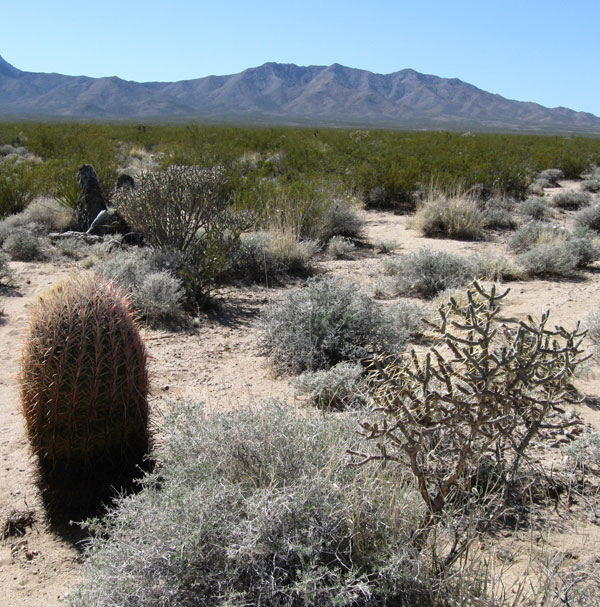
^Ivanpah Valley in eastern San Bernardino County, California, before the utility-scale solar projects. This Mojave Desert ecosystem is now gone. Removing terrestrial biodiversity in the name of energy production is not acceptable to us.
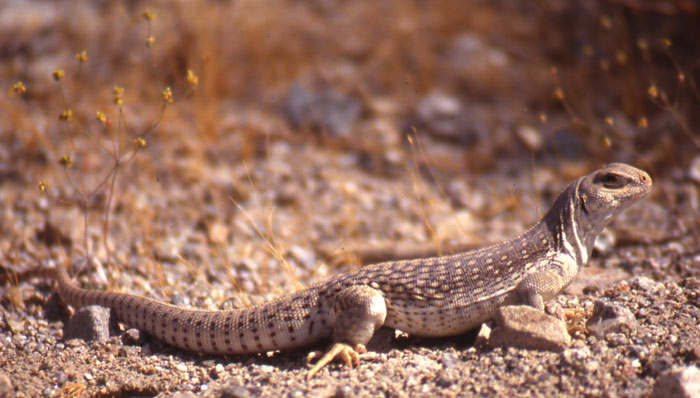
^There is abundant life here: desert iguana (Dipsosaurus dorsalis).

^Desert remover, Cat D-9, hauled into Ivanpah Valley at start of construction of large-scale solar projects.
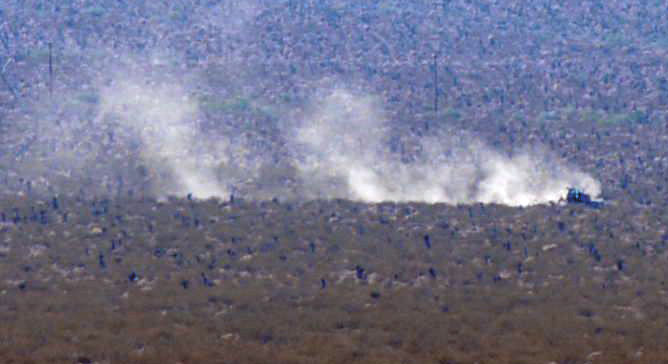
^The bulldozers going to work on the desert ecosystem removing carbon-storing vegetation and life.
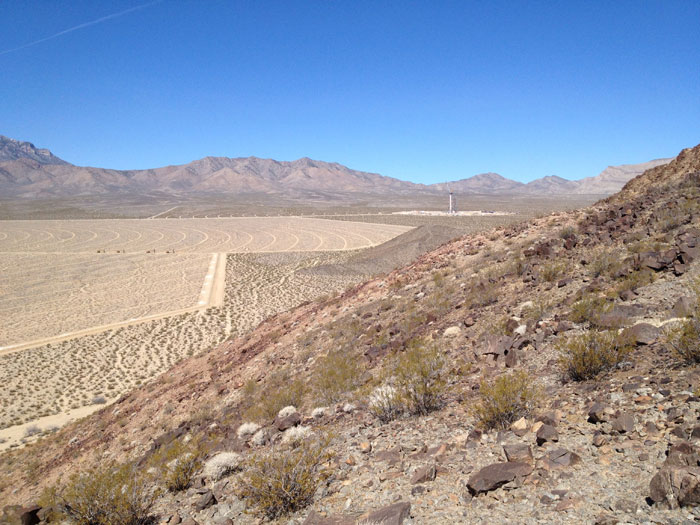
^Ivanpah solar power tower construction on a large scale.
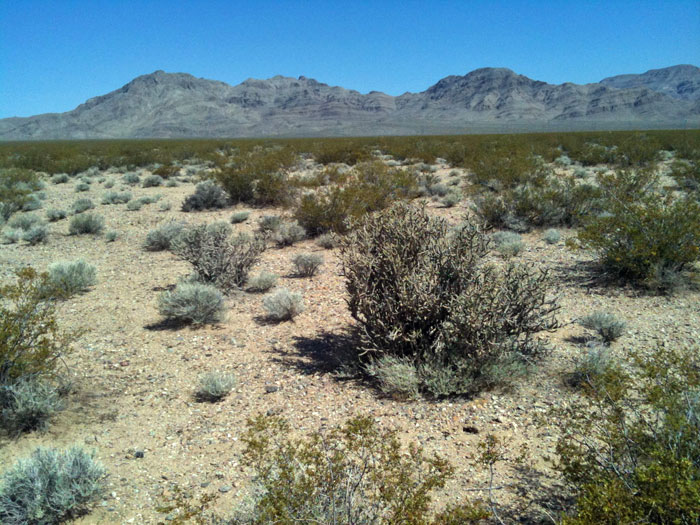
^Gone. Site of future Stateline Solar Farm.

^Stateline Solar Farm edge showing graded Mojave Desert scrub ecosystem.
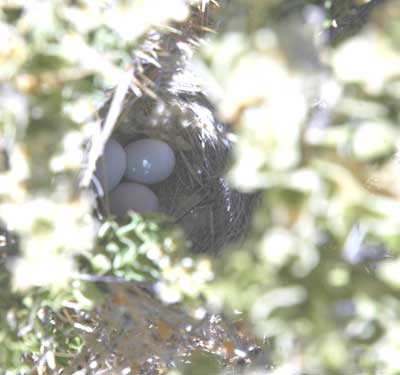
^Black-throated sparrow nest in the way of the bulldozers. The area will be ribboned off until the eggs hatch and fledge, then the desert here will be bulldozed.
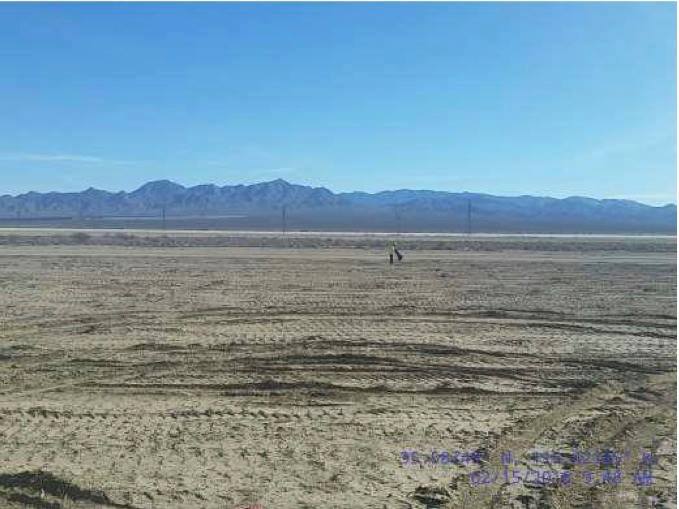
^Stateline Solar Farm scraped.
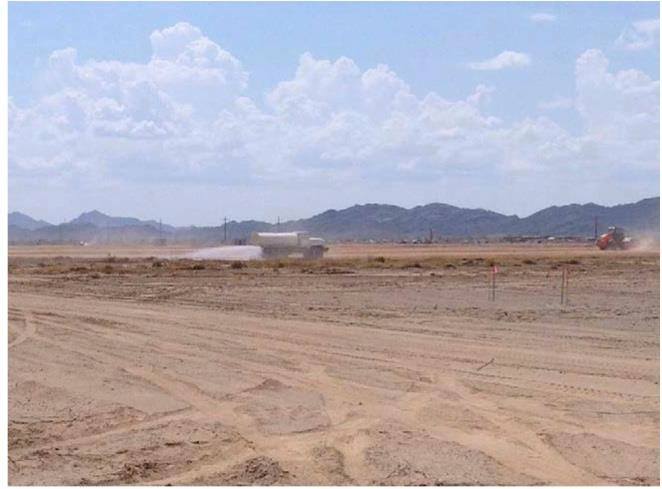
^Water truck trying to control dust at scrape, Blythe Solar Project, Colorado Desert CA.

^Traditional Cultural Landscapes across the desert are threatened by utility-scale solar developments: Colorado River tribal protest at Palo Verde Mesa, Blythe, California.
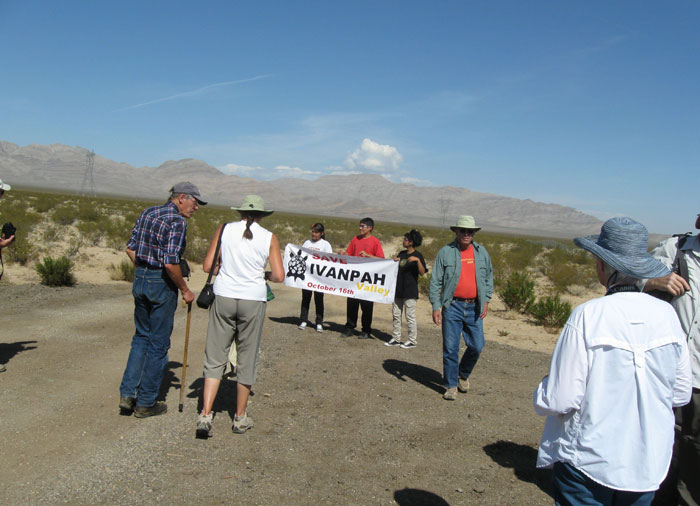
^Protest to save Ivanpah Valley by Native Tribes and desert advocates.

^Spirit Run by Colorado River Tribes on Palo Verde Mesa near Blythe, California, to protest utlity-scale solar development of significant Cultural Landscapes.
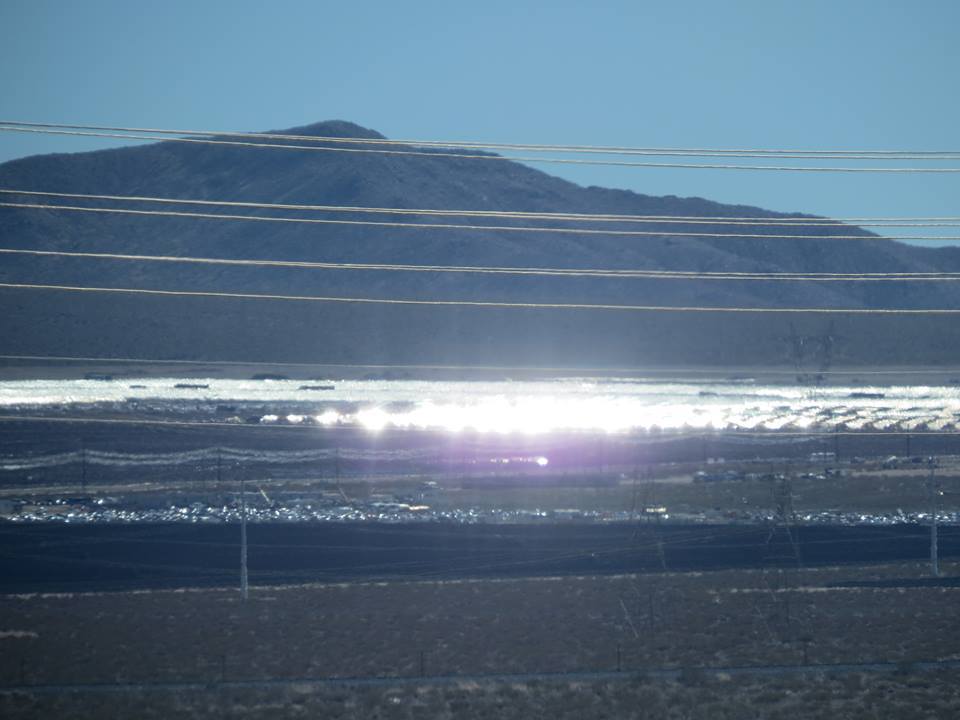
^Flash-glare from photovoltaic panels at Silver State Solar Project, Mojave Desert, Nevada. This was once desert tortoise habitat.
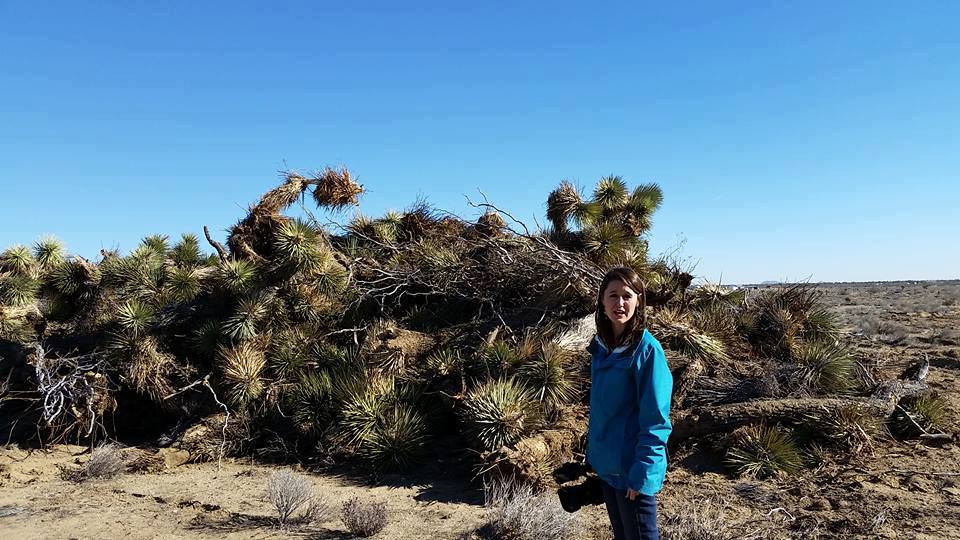
^Joshua trees bulldozed down and piled up to make way for utility-scale solar project, Garland Solar Project, Rosamond, California (Photo by Randy Widmar).
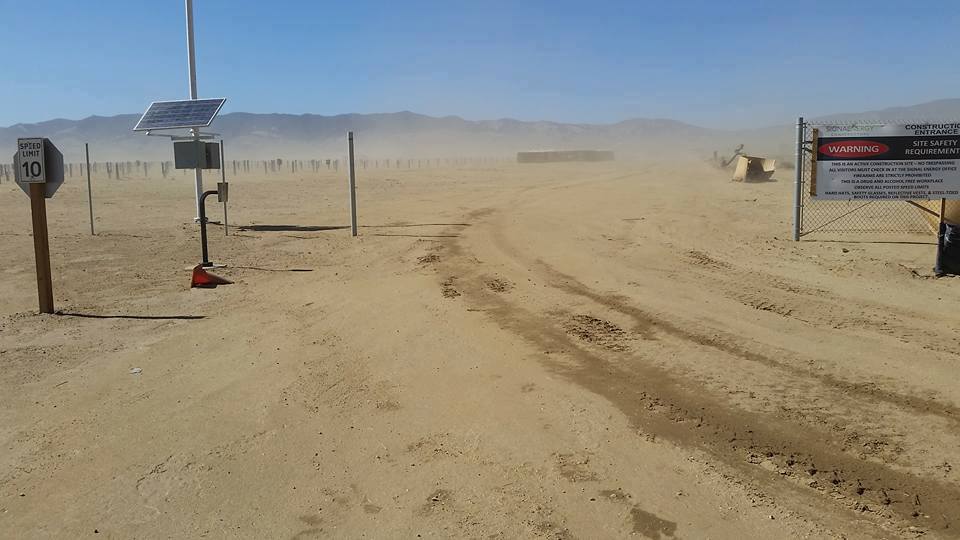
^Former West Mojave Desert, Garland Solar Project, Rosamond, California (Photo by Randy Widmar).
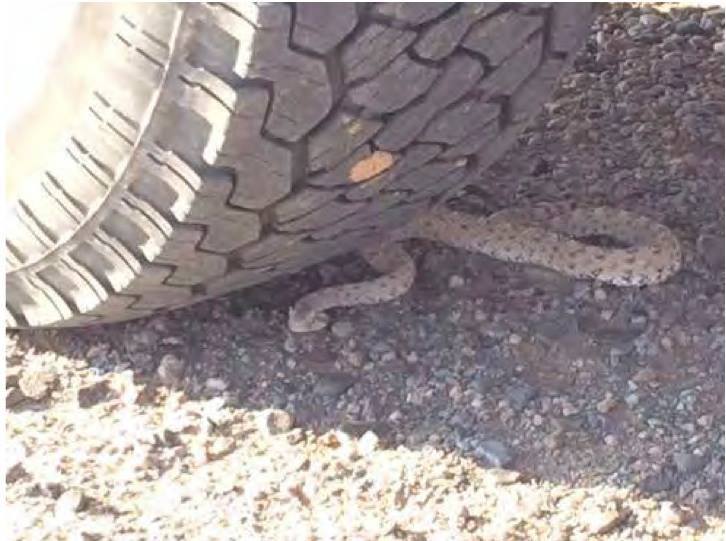
^Sidewinder on construction site, McCoy Solar Project, Colorado Desert, California.
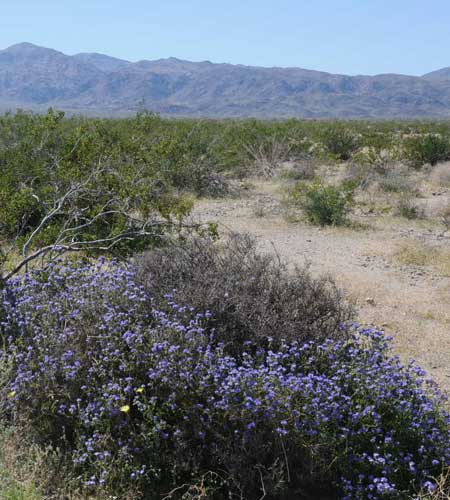
^Before. Phacelia wildflower display in Chuckwalla Valley before the Desert Sunlight Solar Farm was built, scraping this desert ecosystem away.
After: Desert Sunlight Solar Farm. The desert is gone.
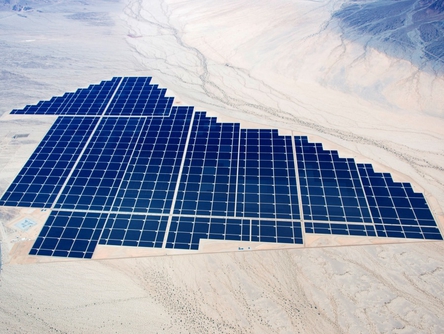
^Desert Sunlight Solar Farm in Chuckwalla Valley, California: the land-use cost is too great, how much Carbon is released from living desert ecosystems and soils when land is developed like this?
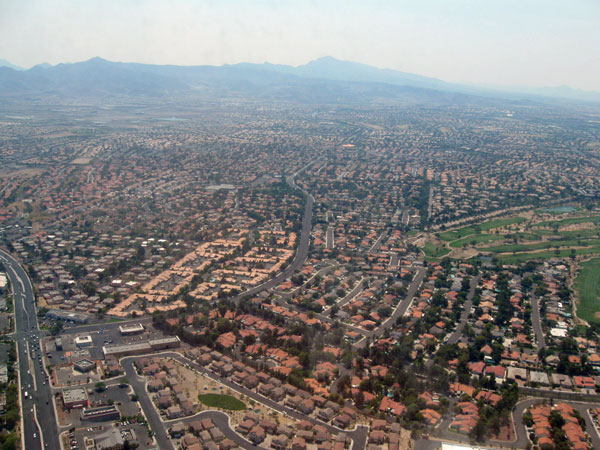
^There is plenty of solar resource in the built environment: rooftop solar plus distributed energy storage.
Distributed Energy Resources can eliminate the need for sacrificing desert ecosystems:
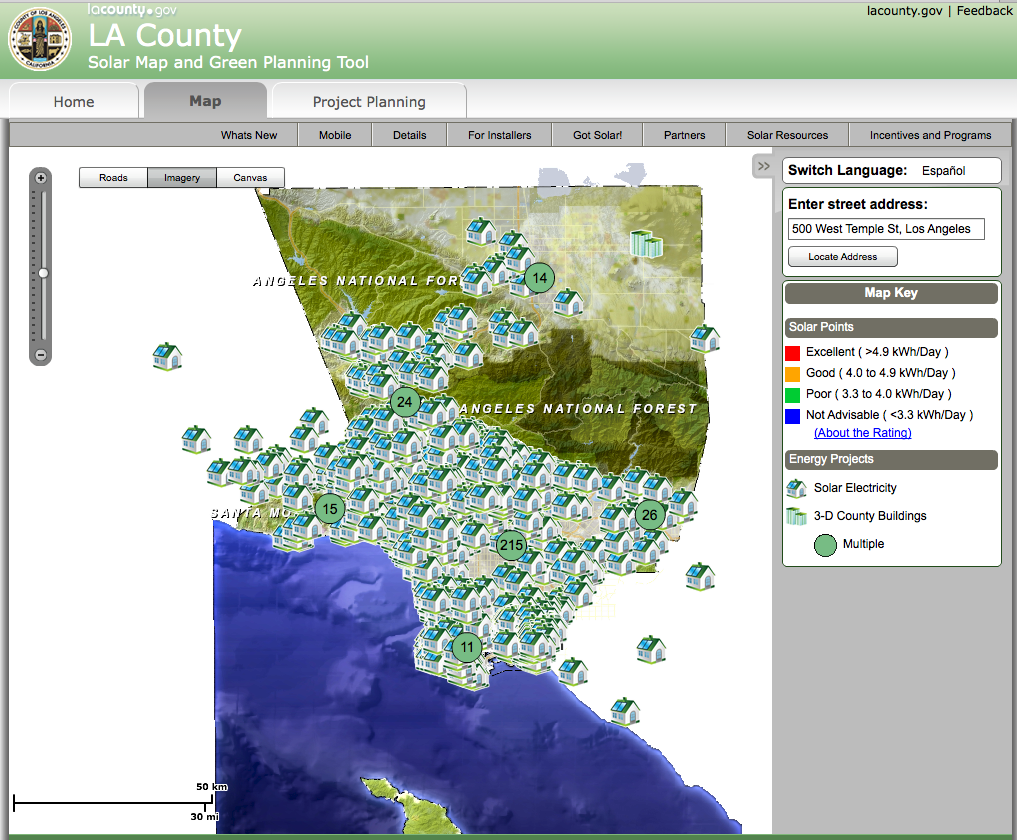
^Los Angeles solar rooftop mapper, the website also gives how much Carbon a rooftop solar system will offset. http://solarmap.lacounty.gov/#
Headline from National Renewable Energy Laboratory in March 2016:
NREL Raises Rooftop Photovoltaic Technical Potential Estimate - NREL
http://www.nrel.gov/news/press/2016/24662
March 24, 2016
Analysts at the Energy Department's National Renewable Energy Laboratory (NREL) have used detailed light detection and ranging (LiDAR) data for 128 cities nationwide, along with improved data analysis methods and simulation tools, to update its estimate of total U.S. technical potential for rooftop photovoltaic (PV) systems. The analysis reveals a technical potential of 1,118 gigawatts (GW) of capacity and 1,432 terawatt-hours (TWh) of annual energy generation, equivalent to 39 percent of the nation's electricity sales.
This current estimate is significantly greater than that of a previous NREL analysis, which estimated 664 GW of installed capacity and 800 TWh of annual energy generation. Analysts attribute the new findings to increases in module power density, improved estimation of building suitability, higher estimates of the total number of buildings, and improvements in PV performance simulation tools.
See the report here: http://www.nrel.gov/docs/fy16osti/65298.pdf
What's at stake in the DRECP:

^Desert kit fox.

^Black-tailed jackrabbit, common desert inhabitant.

^Desert five-spot. We do not need to bulldoze these wildflowers.
^Scraper-graders lined up to continue removing Mojave Desert living ecosystem for utility-scale solar projects in an area with high rare plant diversity.
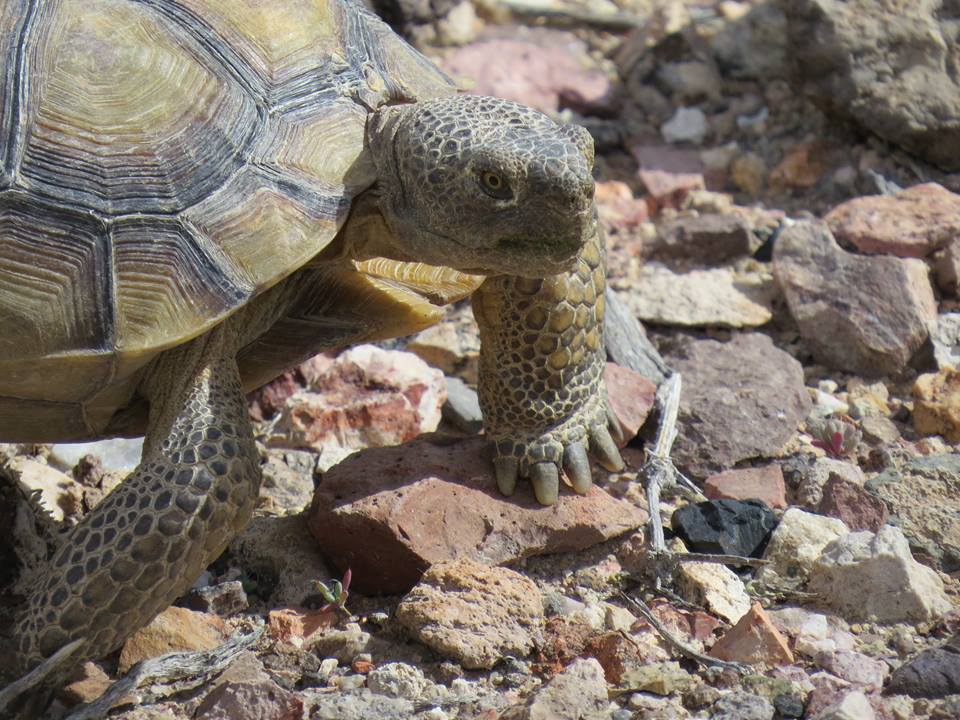
^Desert tortoise.
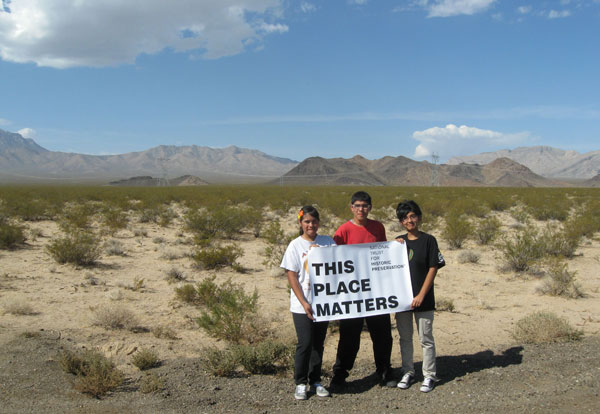
Final DRECP Announced
November 10, 2015 - Washington DC – U.S. Secretary of the Interior Sally Jewell and California Secretary for Natural Resources John Laird today announced the final environmental review of the landscape-scale blueprint to streamline renewable energy development on 10 million acres of federal public lands, managed by the Bureau of Land Management in the California desert. The release of the Final Environmental Impact Statement for Phase I of the Desert Renewable Energy Conservation Plan (DRECP) is part of agency pushes to streamline renewable energy on public lands.
Even with new conservation areas, the DRECP will result in more energy sprawl and a smaller California Desert. This "conservation" plan is full of trade-offs and will probably end up in litigation. Perhaps they would be better off privatizing federal lands with this kind of industry friendly management.
"Phase I of the DRECP, which is managed by the Bureau of Land Management, designates Development Focus Areas with high-quality solar, wind and geothermal energy potential, access to transmission and would allow impacts to be managed and mitigated. Applications will benefit from a streamlined permitting process with predictable survey requirements and simplified mitigation measures, and Interior is considering additional financial incentives through an ongoing rulemaking process."
Silurian Valley would be made a conservation area, but the Soda Mountain basin would not be protected from pending solar developments. The Palen Dunes, which provide sand habitat for the Mojave fringe-toed lizard, have been removed from the Riverside East Solar Energy Zone in eastern Riverside County.
Yet surprisingly, the Searles Lake area famous for the Trona Pinnacles has been added as a renewable energy development zone. This area is famous for Hollywood movie sets from Westerns to Science Fiction, so we are amazed it has been slated for large-scale energy development. The small town of Trona and Searles Dry Lake are currently a remote area with mineral salt mining but the surrounding desert largely untouched and in a primitive setting. Archaeology around Searles Lake is phenomenal, since it was an Ice Age center of early human habitation in North America. We are concerned that the late addition of this area as a Development Focus Area without the ability of the public to comment on a more extensive environmental review will enable the destruction of valuable natural and cultural resources.
Development Focus Areas include 388,000 acres of BLM lands, with many new areas.
Disturbing is the amount of new public lands up for energy development at the last moment:
Variance Process Lands (VPLs). 40,000 acres. Lands that were defined as Study Area Lands in the Draft DRECP. The Draft DRECP included three categories of Study Area Lands: Special Analysis Areas, Future Assessment Areas, and Variance Lands. There are no longer any Special Analysis Areas in the Proposed LUPA. Based on further analysis and public comments, the Special Analysis Areas in the Draft DRECP are now included in either DFAs or conservation designations. The Future Assessment Areas and Variance Lands that remain from the Draft DRECP are now collectively called Variance Process Lands (or VPLs). These lands would be open for solar, wind, and geothermal energy applications under the BLM LUPA. However, all solar, wind, and geothermal energy development applications would have to follow a variance process before the BLM would determine whether to continue with processing them (see Section II.3.3.3.2 for details of the variance process). Applications in Variance Process Lands would not receive the incentives that apply to DFAs (described in Section II.3.3.3.1).
Unallocated Lands. 802,000 acres. BLM-administered lands that do not have an existing or proposed land allocation or designation. These areas would be open to renewable energy applications but would not benefit from permit review streamlining or incentives. The Proposed LUPA includes CMAs that apply to activities in unallocated lands.
http://www.blm.gov/ca/st/en/info/newsroom/2015/november/11-10-15_DRECP.html
"Phased Approach" to DRECP Announced
March 11, 2015 - The The Bureau of Land Management (BLM), U.S. Fish and Wildlife Service (FWS), California Energy Commission (CEC) and California Department of Fish and Wildlife (CDFW) yesterday announced the next steps in the Desert Renewable Energy Conservation Plan (DRECP) after the close of the comment period.
According to the press release from www.drecp.org, based on an initial review of public comments received (12,000 or so were received) on the draft DRECP that were submitted by a diverse group of stakeholders, the agencies are adjusting the planning process and will use a phased approach to approve the plan's three fundamental components: the BLM Land Use Plan Amendment; federal General Conservation Plan; and the state Natural Community Conservation Plan.
The agencies will start by completing the BLM component of the DRECP that designates development focus areas and conservation areas on public lands while providing additional time for the state and federal agencies to work with counties and other stakeholders to address issues and concerns with the General Conservation Plan and the Natural Community Conservation Plan components, including the proposed permitting processes.
Continued engagement with the counties will help determine the best options and timing for proceeding with the private land components and better align renewable energy development and conservation at the local, state and federal level. It will also allow the agencies to explore opportunities for a tailored, county-by-county approach that fits with the DRECP plan.
What we really think may be happening is the counties are pushing back against this massive renewable energy development plan, so the agencies are delaying implementation of the private lands component until later, and moving forward instead with the mostly-federal lands component. But this raises the question of why a DRECP plan is necessary at all if it entails re-writing BLM land use plans for solar and wind energy that have already been written in such massive documents as the Solar Programmatic Environmental Impact Statement, which already has Solar Energy Zones and areas set aside for non-development.
See more at Chris Clarke's KCET ReWire blog.
Our Rooftop Alternative to the Desert Renewable Energy Conservation Plan
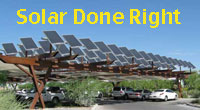
January 30, 2015 - Basin & Range Watch submitted this comment letter today to the Desert Renewable Energy Conservation Plan website. Instead of massive bulldozing of desert ecosystems and fragmentation of rural communities, we propose an alternative that utilizies the California Energy Efficiency Strategic Plan, which is already state law. Enough rooftop and parking lot sites exist to more than fulfill the California electricity need, as well as pushing for more energy efficiency to save energy. We thank Bill Powers of Powers Engineering and Sheila Bowers of Solar Done Right for contributing to this letter. See the letter >>here.
Comment Deadline Extension and Additional Public Meeting in Joshua Tree CA
November 13, 2014 - The California Energy Commission announced today that in repsonse to public comments the deadline for public input to the draft Desert Renewable Energy Conservation Plan (DRECP) will be extended 45 days. Originally the comment deadline was January 9, 2015, now it is February 23, 2015. See www.drecp.org.
An additional DRECP public meeting put on by the Bureau of Land Management is now scheduled for November 19, 2014 at the City of Joshua Tree Community Center, San Bernardino County CA, from 5:30 to 8:30 PM.
Conservation Areas in DRECP With Less Protection Than Hoped For
October 29, 2014 - Basin & Range Watch attended the Ridegrcrest Desert Renewable Energy Conservation Plan (DRECP) meeting and last night and what was disturbing is how National Conservation Lands do not seem to have as much protection as we had hoped. Vicki Campbell of BLM explained to us that both Areas of Critical Environmental Concern (ACECs) and National Conservation Lands (NCLs) in the DRECP have disturbance caps that differ in the various alternatives and between regions. Some are as high as 12%, others below 1%. Present ACECs have a 1% development cap. The Yuha ACEC (Imperial County California) designated to protect the rare Flat-tailed horned lizard (Phrynosoma mcallii) already has 0.9% development in it.
Looking at the Preferred Alternative maps, some Development Focus Areas are on the California-Nevada border. Talking to Greg Helseth of Nevada BLM recently, asking if there are current plans for big transmission projects in Nevada to serve these? He said all transmission will be on California side. Since there are proposed NCL areas and ACECs next to the DFAs, how are they going to hook these DFAs up to the grid? Campbell said transmission in conservation areas will be decided based on the need of a project proposed in a DFA, such as a solar or wind project. Bottom line, we do not know where future transmission will go, since it will be decided later, and we might be looking at large transmission projects cutting right through new conservation areas.
DRECP Meetings
October 24, 2014 - For those planning on attending any of the upcoming Desert Renewable Energy Conservation Plan meetings, we have the following comment suggestions and have linked the meeting schedule: http://www.drecp.org/meetings/
The following would be some suggested talking points: 1. Ask for the comment deadline to be extended another 90 days. 2. Give the planners a hard time for rejecting a distributed generation alternative. Federal agencies are required under the National Environmental Ppolicy Act (NEPA) to consider alternatives outside of their jurisdiction. 3. Tell them that any energy projects in the Development Focus Areas (DFA's) should not be streamlined and full review should be provided for any development. 4. Ask them how possible it will be to have a transmission project built outside a Development Focus Zone and near or in a conservation area. 5. Tell them that streamlining Endangered Species protection in DFA's should not be permitted. For example, say that no golden eagle Take permits should be allowed through DRECP.
Informational Webinar on DRECP
October 15, 2014 - An informational webinar was held on October 9 that was open to the public in order to learn about the Draft DRECP and Environmental Impact Review/Environmental Impact Statement, how to navigate the plan and analysis, and how to provide public comments. The calendar announcement said the webinar would be recorded, but during the webinar it was revealed that the discussion would not be recorded after all despite excellent questions brought up by member of agencies and the public. We took brief notes during the webinar and can provide a summary.
After a presentation summarizing the DRECP (which can be seen on YouTube), Chris Beale, DRECP Acting Executive Director, led a question and answer session along with other multi-agency representatives of the DRECP planning effort.
One question from a Bureau of Land Management employee asked how mitigation would be insured over time? An example was given of a transmission project where the agency is still trying to find ways to mitigate impacts four to five years later. The answer is an in lieu option to insure mitigation will happen. The DRECP planners said they would take care of developer's impacts on the ground.
There is no plan in the DRECP to close open Off-Highway Vehicle routes in new Conservation Areas. The DRECP does not deal with undesignated OHV routes. in Development Focus Areas, development will be directed around designated routes.
The West Mojave Plan is coming out in February, will it be compatible with the DRECP? The answer was yes.
The goal of 20,000 megawatts of renewable energy will be market-driven. The MWs may be less depending on how rooftop solar and distributed generation goes and how conservation goals are met, according to Beale. "We expect it to be less." Large Development Focus Areas (DFAs) were identified in order to provide flexibility, avoid conflicts, but these areas are not locked up. They expect 177,000 acres could be built out to achieve the 20,000 MWs, within the 22 million acres identified.
How much groundwater will be allowed to be taken? The DRECP does not deal with other groundwater impacts other than renewable energy. The Final DRECP may be modified in light of new issues and events such as the signing of new state water laws last week. These specify mandates for sustainable groundwater management on local agencies in high- and medium-priority groundwater basins. The California Department of Water Resources will identify which groundwater basins have to be managed. By January 31, 2015, it will establish the initial priority—high, medium, low, or very low—for each groundwater basin in the state. Only high- and medium-priority basins will be subject to sustainable groundwater management mandates. Groundwater sustainability agencies may then be formed locally within two years and these will adopt a groundwater sustainability plan within five.
Questions concerning financial incentives for developers to go to Development Focus Areas on public land were referred to Volume II.2.3.2.1 of the DRECP. BLM will offer 30-year fixed term leases with fixed rental fees in what are basically de fact Solar Energy Zones, since similar lease arrangements became policy for SEZ's in the Solar Programmatic EIS. There will be a fixed or standard bond per acre in the DFAs. Supposedly economic benefits to solar and wind developers would occur in DFAs due to "upfront data collection" that allows lower cost recovery, longer phase-in periods for rental payments. BLM will charge fixed megawatt capacity fee rental payments. BLM will develop mitigation strategies to "simplify the mitigation process and provide financial certainty" (page II-3-305). Transmission projects to DFAs will be prioritized. Incentives are not outlined on private lands.
Troubling to us is the apparent policy in the DRECP where land in the DFAs where solar, wind, and/or geothermal projects can apply, will be streamlined with a single National Environmental Policy Act document, wildlife and plant surveys can be done once for multiple technologies, and mitigation split between three types of renewable energy projects. The surveys for wind and solar projects can be very different, as can be mitigation and compensation, so we are concerned this is too much of a simplification to conserve resources and follow the intent of NEPA. (See page II.3-308.)
Conservation for rare plants was brought up. This was said to be "always a challenge in conservation plans." In Conservation Management Areas (CMAs) surveys for all plants will be done at proposed project sites. Avoidance and protective buffers will be designed. The DRECP planners said there are a lot known plant occurrences and modeled habitat in CMAs. For particularly rare plants, modeled habitat will be mitigated. This troubles us as well -- we are now taking conservation to the abstract level of mitigating computer models, not reality on the ground.
Appendix K address high-level transmission planning, based on the Renewable Energy Action Team agencies' plans. Various alternatives are presented, but routes on the ground are not yet planned.
Basin & Range Watch asked whether renewable energy projects within the DFAs will be reviewed with Environmental Assessments (EAs) under NEPA? Will the public still get scoping meetings? The answer was that the DRECP has not determined if an EA, and Environmental Impact Statement (EIS), or even a Categorical Exclusion (basically no public review) will be mandated, there is no requirement generally. This will be determined on a project-by-project basis. The public can request scoping meetings even if it is an EA. "No NEPA requirements will be foregone," Beale assured everyone. Another DRECP planner added that it was "highly unlikely" a large solar project would get a Categorical Exclusion in a DFA.
A Riverside County representative asked what the implementation structure would be for projects on private land? The DRECP planners explained there would be four ways the county can participate under DRECP:
1. Informally by working with the agencies.
2. A formal way by joining a work group. The project would still go through the usual local review and permit. Take Permits from US Fish and Wildlife Service and California Department of Fish and Wildlife would be needed.
3. There will also be an option to apply for a permit under the DRECP that would be very streamlined. The county would agree to get the project proponents to do the minimum measures and the county could extend the Take Permit.
4. The last option would be like a Multispecies Habitat Plan. The county would apply for a Take Permit and other activity permits, and use DRECP's mitigation measures. The county could extend the Take Permit to other projects other than renewable energy, not analyzed in the DRECP. This is a more involved permit.
Streamlining permits to us equates to cutting short needed conservation measures for the California Desert.
See the DRECP website: http://www.drecp.org/
See also the Mojave Desert Blog's excellent Spotlights of the DRECP: http://www.mojavedesertblog.com/2014/10/drecp-spotlight-conservation.html
Public Meetings
October 4, 2014 - Public meetings are scheduled for discussion of the DRECP:
http://www.energy.ca.gov/releases/2014_releases/2014-10-03_DRECP_Public_Meetings_nr.pdf
SACRAMENTO, Calif. – The Bureau of Land Management (BLM), U.S. Fish and Wildlife Service (FWS), California Energy Commission (CEC) and California Department of Fish and Wildlife (CDFW) announced today the dates and locations of several public meetings for the draft Desert Renewable Energy Conservation Plan (DRECP) Environmental Impact Report/Environmental Impact Statement (EIR/EIS).
Public meetings will be held throughout the DRECP planning area and surrounding population centers between Oct. 20 and Nov. 13. The meetings are designed to help the public understand the draft DRECP EIR/EIS and to facilitate public comments. Meetings will include a presentation, information stations and an opportunity to submit recorded verbal and written comments.
The draft DRECP is an innovative renewable energy and conservation plan covering more than 22 million acres of land in Imperial, Inyo, Kern, Los Angeles, Riverside, San Bernardino and San Diego counties. The draft is the result of collaboration among the BLM, FWS, CEC, CDFW and other stakeholders.
The draft proposes to protect areas in the California desert that are important for wildlife, recreation, cultural and other uses while also facilitating the timely permitting of solar, wind and geothermal energy projects and associated transmission in appropriate areas. The draft plan presents six alternative approaches for meeting renewable energy and conservation goals through 2040. Each alternative proposes a different conservation design and configuration of lands available for more efficient and predictable renewable energy project review. The draft plan also includes an analysis of the potential environmental impacts of these alternatives.
Public meetings will be held at the locations, dates and times listed below. Some of these meetings will also be broadcast by WebEx to allow for remote attendance. Please visit www.drecp.org to confirm meeting details and WebEx availability.
Monday, October 20, 4:00-6:30 p.m.
Imperial Irrigation District Board Room 1285 Broadway Ave. El Centro, CA 92243
Tuesday, October 21, 6:30-9:00 p.m.
Hilton San Diego Mission Valley 901 Camino Del Rio South San Diego, CA 92108
Monday, October 27, 4:00-6:30 p.m.
Statham Hall 138 Jackson St. Lone Pine, CA 93545
Tuesday, October 28, 4:00-6:30 p.m.
Kerr McGee Community Center 100 W. California Ave. Ridgecrest, CA 93555
Wednesday, October 29, 4:00-6:30 p.m.
Hilton Garden Inn 12603 Mariposa Rd. Victorville, CA 92395
Monday, November 3, 4:00-6:30 p.m.
Lancaster City Hall Council Chambers 44933 N. Fern Ave. Lancaster, CA 93534
Wednesday, November 5, 4:00-6:30 p.m.
Palo Verde Community College Room CL 101 1 College Dr. Blythe, CA 92225
Thursday, November 6, 6:30-9:00 p.m.
Ontario Convention Center 2000 E. Convention Center Way Ontario, CA 91764
Friday, November 7, 4:00-6:30 p.m.
UC Riverside, Palm Desert Center Auditorium 75080 Frank Sinatra Dr. Palm Desert, CA 92211
Thursday, November 13, 2:00-4:30 p.m.
California Energy Commission Hearing Room A 1516 9th St. Sacramento, CA 95814
A recorded informational webinar to help the public navigate the DRECP documents is available at www.drecp.org. The webinar may be viewed online, and will also be broadcast on Oct. 9 from 4:00-6:00 p.m. at locations listed on the website. The website also contains instructions for providing written comments on the draft document.
The DRECP’s formal public comment period runs through Jan. 9, 2015.
The draft DRECP EIR/EIS is available for review and download at www.drecp.org, and at local libraries and agency offices. A DVD will be provided upon request. To request a DVD, please send an email request to drecp.info@energy.ca.gov or call (866) 674-9996 and provide a mailing address. For a list of local area libraries and agency offices that have the document on file (most are on DVD), please visit www.drecp.org/draftdrecp.
DRECP Excuses
October 2, 2014 - The Draft Desert Renewable Energy Conservation Plan (DRECP) is out. Any attempts to detail the 22 million acres are really a bait and switch for the public. Choosing parts of the desert to rescue from the bulldozer, while missing other equally imprtant and scenic regions is a losing game for the great open spaces of the California desert in our opinion.
There is a list of excuses for rejecting the Distributed Generation alternatives. The quote below is why a brownfield or disturbed land alternative was rejected. So are rooftops not “private, disturbed land”? How about parking lots? There is not enough private or disturbed land in all of southern California?
In the Alternatives chapter, “Siting renewable energy only on private land would not provide balance or flexibility in siting renewable energy development because there is limited private land throughout the DRECP Planning Area and the private land does not always correlate with areas with the
highest energy resource values. In some instances, development on private land would not align with existing transmission corridors. Meeting statewide and federal renewable energy goals within the DRECP planning area boundary exclusively on private lands would result in substantial conflicts with current and proposed land uses on private lands. Some counties expressed concern that development of renewable energy on private land could impact county land-use programs and controls, and could negatively affect local economies, county resources, local character, jobs, property tax revenue, agriculture, and recreation and historical resources (County of Riverside 2011a, DRECP 2011a). Private lands that were not incorporated into the analyzed alternatives have high biological resource conflicts and do not align with DRECP purpose and need. For these reasons, the Private and
Previously Disturbed Lands Alternative was not retained.”
For a CD of the massive document, contact:
Chris Beale,
DRECP Acting Executive Director
Email: cbeale@resourceslawgroup.com
Phone: 916-442-4880
Desert Renewable Energy Conservation Plan Is Out

September 23, 2014 - Here is the summary of the preferred DRECP alternative:
It calls for 2 million acres of development focus areas and acknowledges in the back of the document unmitigatable impacts to scenic vistas near national parks and wilderness areas.
See the 60-page summary:
http://www.documentcloud.org/documents/1304035-desert-renewable-energy-conservation-plan.html
Here is the link to the entire draft DRECP: http://drecp.org/draftdrecp/
Basin & Range Watch Recommends Agencies Follow the Final Report of the Independent Science Advisors to the Desert Renewable Energy Conservation Plan
http://www.drecp.org/documents/index.html#science
Interim Document
December 18, 2012 - California state and federal agencies released an interim document on the Desert Renewable Energy Conservation Plan (DRECP) .
Renewable energy impacts could lead to the destruction of between 200,000 to 350,000 acres of the California desert under this proposed plan.
Input can be provided through the DRECP website at www.drecp.org and will be accepted throughout the DRECP planning process. Members of the public can also sign up on the website to receive updates on the plan via the DRECP listserve. To be most useful and fully considered prior to publication of the Draft EIS/EIR, input on the interim document should be submitted by January 23, 2013.
The interim document and a fact sheet about it can be found at http://www.drecp.org/documents/
DRECP New Website
August 9, 2010 - The Desert Renewable Energy Conservation Plan is a cooperative agency plan to site renewable energy projects in a way that is responsible to conservation concerns, sensitive biological resources, and ecological processes. Unfortunately it is coming too late, as large projects are being sited in an irresonsible way, damaging fragile desert resources. We will be reviewing the latest August Draft Plan, which has good recommendations, but in the meantime here is the new website: http://www.drecp.org/
On November 17, 2008, Governor Arnold Schwarzenegger signed Executive Order # S-14-08 that sets California's goal of 33 percent of electricity coming from renewable resources by 2020 and improves processes for licensing renewable projects. In addition, the Governor ordered the development of the Desert Renewable Energy Conservation Plan (DRECP) for the Mojave and Colorado deserts that would, when complete, provide binding, long-term endangered species permit assurances and facilitate renewable energy project review and approval processes.
To oversee the implementation of the DRECP, a Renewable Energy Action Team (REAT) was formed consisting of the California Natural Resources Agency, California Energy Commission, California Department of Fish and Game, Bureau of Land Management, and the U.S. Fish and Wildlife Service. Memoranda of Understanding (MOUs) were signed by the participating agencies. Others joining the team include the California Public Utilities Commission, California Independent System Operator, National Parks Service, and the Department of Defense.
Four major products are being developed under the Renewable Energy Executive Order and the REAT:
Best Management Practices and Guidance Manual: Desert Renewable Energy Projects. (The Revised Staff Draft (PDF file, 2.4 MB) version is currently available.)
Draft Conservation Strategy that clearly identifies and maps areas for renewable energy project development and areas intended for long-term natural resource conservation as a foundation for the DRECP.
Desert Renewable Energy Conservation Plan -- a joint state and federal Natural Communities Conservation Plan (NCCP) and part of one or more Habitat Conservation Plans (HCP).
DRECP Draft and Final joint state and federal Environmental Impact Report/Environmental Impact Statement.
Salazar Plans to Expedite Renewables on California Desert
October 9, 2009 - See early history of the DRECP >>here.
HOME.....Basin & Range Watch Comment Letter.....2009 DRECP and Fast-tracking Renewable Energy
